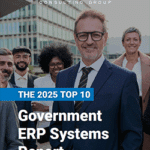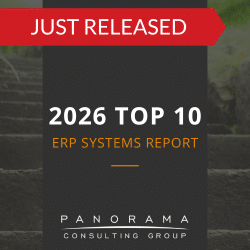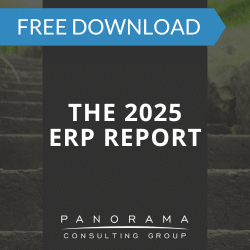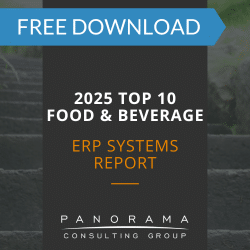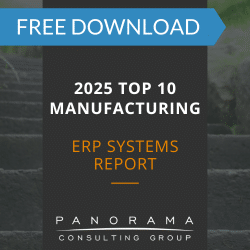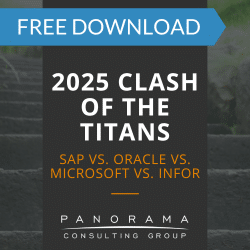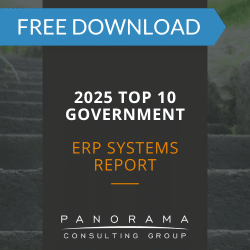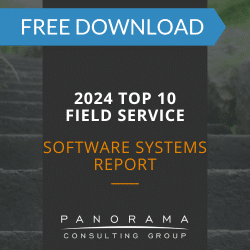Choosing the right ERP system can increase business efficiency and enable scalability. However, organizations evaluating ERP software have hundreds of systems to choose from, making the ERP comparison process daunting.
Where do you even start?
Our 2026 Top 10 ERP Systems Report highlights the vendors that the Panorama team frequently evaluates for clients across industries. By providing insights into the top 10 ERP software in the world, our goal is to simplify your search among the myriad of ERP software companies and help you select a vendor that will drive your business forward.
Whether you’re in manufacturing, retail, or services, it’s important to have a broad understanding of the most trusted ERP software vendors globally, from industry giants to innovative up-and-comers.
Our comprehensive guide lists ERP system vendors that have been rigorously evaluated for functionality, user-friendliness, and integration capabilities. Make an informed decision with our guide to the best ERP software:
The 2026 Top 10 ERP Systems Report
What vendors are you considering for your ERP implementation? This list is a helpful starting point.
Preview of the Top 10 ERP Software System Vendors
Our report provides more specific details, but below is a brief overview of the top products from the best ERP system vendors (in alphabetical order):
Acumatica

Acumatica provides a cloud-based ERP with micro-vertical functionality designed for small and mid-sized businesses. It integrates various business functions, including Financial Management, Customer Management (CRM), Manufacturing, Distribution, and more.
Epicor

Epicor provides cloud and on-premise solutions for a variety of industries. The ERP system featured in our report is Epicor Kinetic, a solution designed for discrete, make-to-order manufacturers.
IFS
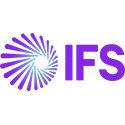
IFS Cloud’s single centralized platform provides ERP capabilities as well as Enterprise Asset Management and Service Management capabilities.
Infor
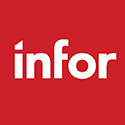
Infor CloudSuite ERPs are AI-powered and industry-specific. They are designed to streamline operations across manufacturing, distribution, healthcare, and government operations.
Microsoft
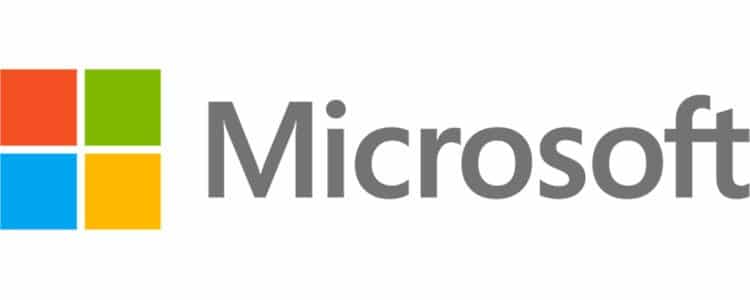
Microsoft Dynamics 365 is a portfolio of intelligent business applications. Businesses can connect Dynamics 365 applications with the systems and tools they already use.
NetSuite

The NetSuite ERP system is an all-in-one cloud solution that provides real-time visibility into operational and financial performance. The solution is designed for organizations of all sizes.
Oracle

The Oracle system featured in our top ERP systems report is Oracle Fusion Cloud ERP. It is a complete suite of SaaS applications with embedded artificial intelligence for automating, standardizing, and integrating processes and data.
Sage

Sage is designed for startup, scale-up, and enterprise-sized companies. Sage Intacct is included in our top 10 ERP systems report as it can adapt to the unique workflows and reporting requirements of almost any industry.
SAP
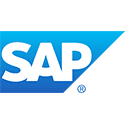
The SAP system featured in our report is SAP S/4HANA Cloud. This system covers a broad spectrum of business needs and embeds industry best practices for services, manufacturing, public sector, and more.
Workday

Natively built for cloud delivery, Workday provides enterprise management cloud applications that help organizations manage their finance, human resources, and planning processes in a single system.
The Benefits of a Strategic ERP Selection Process
Modern ERP systems act as enablers of growth and innovation across business functions. By aligning your ERP implementation with strategic priorities, you can unlock long-term value from your software investment. Here are some of the long-term benefits you can expect:
1. Scalability to Support Business Growth
As you expand into new markets, launch new product lines, or acquire other businesses, scalability becomes essential.
Look for an ERP system that is designed to grow with your organization, providing flexibility to add new modules as the need arises. This is critical for avoiding costly system replacements and maintaining consistent performance amid expanding operations.
2. Data-Driven Decision-Making and Resilience
Real-time data should flow across business units, helping you respond quickly to disruptions and market shifts.
Look for a system with advanced analytics capabilities that empower leadership teams to make faster, more informed decisions. This level of agility is critical in today’s volatile business environment.
3. Customer Experience as a Competitive Advantage
In an increasingly customer-centric world, ERP systems play a key role in delivering superior service.
The best ERP systems unify customer data across touchpoints, from sales and support to fulfillment. This allows you to anticipate needs and improve customer support, fostering loyalty and driving revenue growth.
Learn More About ERP Selection
Our top 10 ERP platform comparison is only the starting point to selecting the right enterprise software system. More ERP selection tips can be found in our ERP Selection Guide.
Your organization ultimately needs to decide which selection criteria are most important, then narrow down your options based on these criteria. This may or may not lead you to consider one of the top ERP systems.
Panorama’s ERP consultants have helped hundreds of organizations select the right enterprise software and develop an effective project plan. Contact us below and be sure to download our 2026 Top 10 ERP Systems Report.


